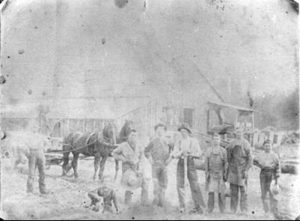In January 2010, Mississauga officially expanded, adding land along the west side of Ninth Line in what was formerly part of Trafalgar Township in Halton County. As a result of this expansion of our western border, a property known as the O’Hara House (5104 Ninth Line) became part of the City of Mississauga. Built circa 1848, the O’Hara house helps to connect the surrounding area to its historic roots, and namely to the lost village of Diamond, also known as the “Catholic Swamp”. The O’Hara house remains a private property today.
 The house is believed to be the third home of the O’Hara family. Charles O’Hara Sr. was a native of County Antrim, Ireland, and arrived in Canada in the spring of 1819, accompanied by a number of other Irish Catholic families who set up residence on the periphery Trafalgar Township. Their life would not have been an easy one, although we know precious little for certain.
The house is believed to be the third home of the O’Hara family. Charles O’Hara Sr. was a native of County Antrim, Ireland, and arrived in Canada in the spring of 1819, accompanied by a number of other Irish Catholic families who set up residence on the periphery Trafalgar Township. Their life would not have been an easy one, although we know precious little for certain.
We can pick up the thread of the O’Hara family through the local parish records: Charles O’Hara Jr. and his brother-in-law, Bartholomew O’Connor, are acknowledged with having walked over 40 miles to the town of Dundas and to persuade a Father O’Reilly to come to the “Catholic Swamp” to celebrate Catholic mass in 1819. The first mass for the burgeoning crossroads community was held in the O’Hara log cabin. For many of the early settlers, this was likely the first mass they had observed since leaving Ireland.
Visits by travelling ministers continued sporadically until 1823, when a congregation was officially established their first log church – the forerunner of St. Peter’s Roman Catholic Mission Church on Ninth Line. The O’Hara log cabin, likely built by Charles Sr. around 1819, was located near the modern intersection of Ninth Line and Eglinton Avenue.
Charles Sr. officially obtained title to his land from the Crown on April 30, 1830, likely replacing the original log cabin with a small stone house around that time. A year later, on July 14, 1831, Charles Sr. transferred this 100-acre lot to his son, Charles Jr. Around 1848 Charles Jr. built a more substantial Georgian-style farmhouse, originally connected to the older masonry house. This third house was built from red brick, harvested from the farm – this is the house which survives today.
The family operated a small sawmill on the branch of the Sixteen Mile Creek which traversed their property. The O’Hara family connection with the property and house continued until 1948.
In terms of the O’Hara family, we hope that readers might be able to assist us in gathering information and pictures, as we do not have a great deal of information on the history of this area of Mississauga or on the many families who settled here.
If you would like to share your stories or have information on the O’Hara family, please email us at [email protected].
Sláinte!



Comments are closed.